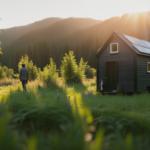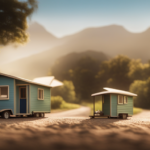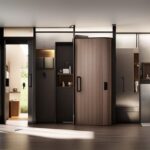Prefab Tiny Houses
How Did the Tiny House Movement Start

As I explore the beginnings of the tiny house movement, a fascinating story emerges. It all started during the aftermath of the 2008 Financial Crisis, when a longing for simplicity and financial independence started to grow.
A group of brave souls embraced minimalism, downsizing their lives to the essentials. These innovators paved the way for a sustainable living movement, driven by environmental consciousness and off-grid solutions.
Through the power of social media, their message spread like wildfire, inspiring countless others worldwide.
Key Takeaways
- The Tiny House Movement originated in the aftermath of the 2008 Financial Crisis and was driven by the unstable housing market and the desire for sustainable and affordable housing options.
- Embracing minimalism and downsizing are core principles of the movement, with individuals prioritizing experiences and relationships over material possessions.
- Pioneers and innovators like Jay Shafer challenged traditional norms of home construction by designing unconventional and innovative tiny houses with creative storage solutions and multi-functional furniture.
- The movement promotes sustainable living and off-grid solutions, including utilizing renewable energy sources, rainwater harvesting, and emphasizing a simpler, more sustainable lifestyle.
The Financial Crisis of 2008: A Catalyst for Change
During the financial crisis of 2008, I realized that I needed to make some major changes in my life. The financial implications of the crisis were widespread, affecting not only the economy but also individuals like me.
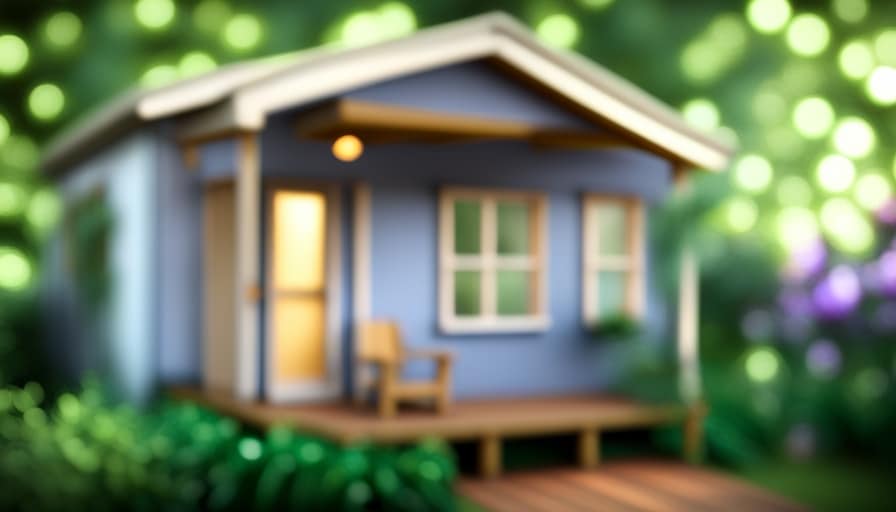
One of the areas hit hardest was the housing market, which experienced significant fluctuations. Many people lost their homes or faced foreclosure due to the unstable market conditions. Witnessing the devastating impact of the crisis on families and communities made me reflect on my own financial situation.
I realized that I needed to find a more sustainable and affordable housing option. This realization was the catalyst for my interest in the tiny house movement, as I saw it as a way to downsize, reduce my expenses, and regain control of my financial future.
The Simplicity Movement: Embracing Minimalism and Downsizing
I embraced the simplicity movement and downsized my possessions, realizing that I didn’t need as much stuff as I thought. This led me to adopt a minimalist lifestyle and embrace the concept of small space living.
The simplicity movement is all about stripping away unnecessary clutter and focusing on what truly brings joy and meaning to our lives. It encourages us to let go of material possessions that no longer serve a purpose and instead prioritize experiences and relationships.
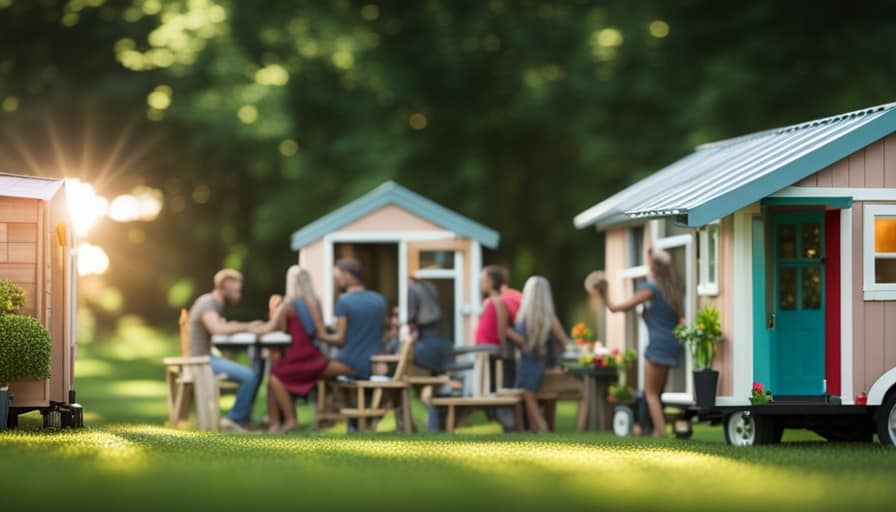
Living in a small space has its challenges, but it also offers numerous benefits. It forces us to be intentional with our belongings and teaches us to appreciate the little things. It also promotes sustainability and reduces our environmental impact.
Innovators and Trailblazers: Pioneers of the Tiny House Movement
While many individuals contributed to the growth of the tiny house movement, one of the key figures was Jay Shafer, who’s often credited as the pioneer of the modern tiny house movement. Shafer, along with other pioneering architects, brought a fresh perspective to the world of housing design by creating unconventional and innovative tiny house designs.
These architects challenged the traditional norms of home construction, focusing on minimalism, sustainability, and efficiency. Through their work, they showed that it was possible to live comfortably in a small space without sacrificing quality of life. Their designs often incorporated creative storage solutions, multi-functional furniture, and clever use of natural light to maximize the limited space available.
These pioneers paved the way for the tiny house movement, inspiring others to embrace simplicity and downsizing as a means of achieving a more sustainable and fulfilling lifestyle.
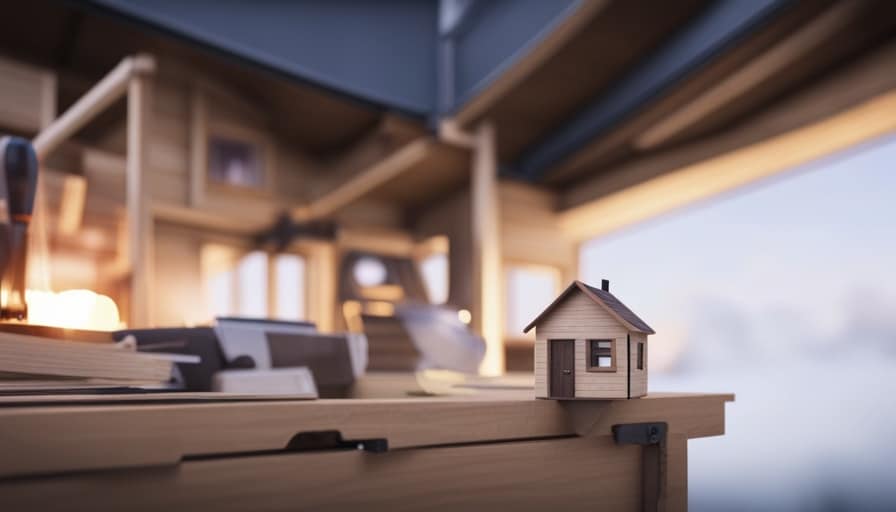
Sustainable Living: Environmental Consciousness and Off-Grid Solutions
As I delved deeper into the world of tiny houses, I discovered that sustainable living and off-grid solutions have played a significant role in shaping the movement.
Tiny houses are known for their minimal environmental impact and focus on self-sufficiency. By utilizing renewable energy sources such as solar power and rainwater harvesting, tiny homeowners are able to reduce their reliance on traditional utilities. This not only minimizes their carbon footprint but also allows them to live off-grid, meaning they’re completely self-sufficient and don’t rely on public utilities.
Additionally, the smaller size of tiny houses encourages a simpler, more sustainable lifestyle, with less consumption and waste. The emphasis on sustainable living and off-grid solutions is one of the core principles of the tiny house movement, appealing to those who desire to live in harmony with the environment while serving others.
The Impact of Social Media: Spreading the Tiny House Movement Worldwide
With social media platforms like Instagram and Facebook, the tiny house movement has been able to spread worldwide, inspiring people from all walks of life to embrace a simpler and more sustainable way of living. The impact of social media on the tiny house movement can’t be understated. Here are some key points to consider:
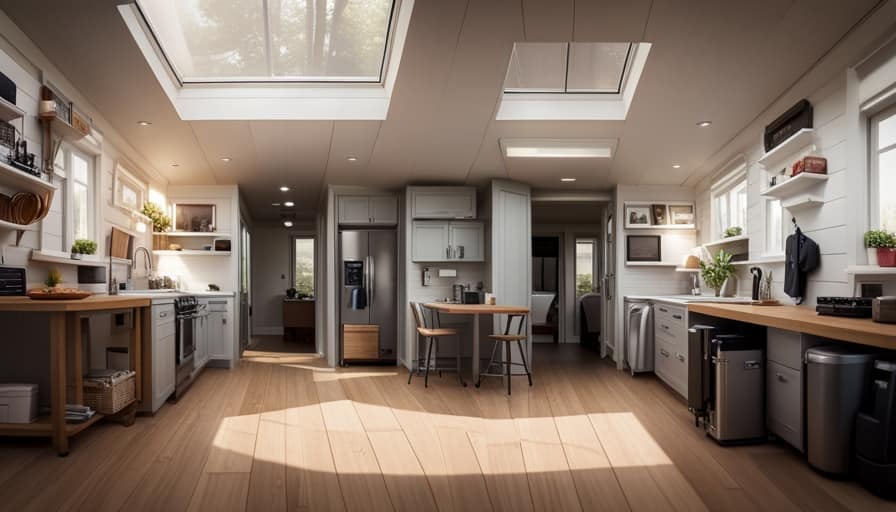
-
Social media influencers: Influencers play a significant role in promoting the tiny house lifestyle. Their posts and stories showcasing their own tiny homes and experiences inspire and educate a wide audience.
-
Online communities: Online platforms dedicated to the tiny house movement provide a space for enthusiasts to connect, share ideas, and support one another. These communities foster a sense of belonging and empower individuals to pursue their tiny house dreams.
Through social media, the tiny house movement has gained momentum, reaching people worldwide and creating a global community of individuals passionate about sustainable living.
Frequently Asked Questions
What Are the Average Costs Associated With Building and Maintaining a Tiny House?
On average, the costs of building and maintaining a tiny house can vary depending on factors such as size, materials, and location. Financing options like loans or personal savings can help cover these expenses.
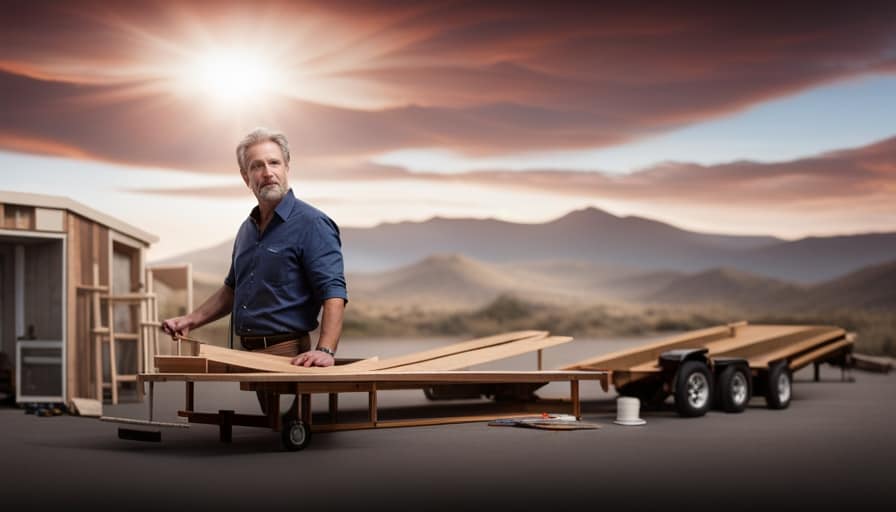
Are There Any Legal Restrictions or Regulations When It Comes to Living in a Tiny House?
When it comes to living in a tiny house, there can be legal implications and zoning regulations to consider. For example, some areas may have restrictions on where you can park or live in a tiny house.
How Do Tiny House Dwellers Handle Basic Utilities Such as Water, Electricity, and Sewage?
When it comes to off grid living in a tiny house, handling basic utilities can be a challenge. Tiny house dwellers often rely on alternative methods such as rainwater collection, solar power, and composting toilets for sustainable living.
What Are the Challenges and Benefits of Living in a Tiny House With a Family or a Pet?
Living in a tiny house with a family or pet has its challenges, like limited space and privacy. However, the benefits of a minimalistic lifestyle, such as lower expenses and a closer bond with loved ones, make it worthwhile.
Are There Any Specific Design Considerations or Techniques That Are Commonly Used in Tiny House Construction to Maximize Space?
To maximize space in tiny house construction, innovative storage solutions and multi-functional furniture are commonly used. It’s like fitting a puzzle together, finding clever ways to store belongings and make every inch count.

Conclusion
In conclusion, the tiny house movement has evolved from a response to the financial crisis of 2008 into a global phenomenon.
Through the simplicity movement, innovators and trailblazers have embraced minimalism and downsizing, while also prioritizing sustainable living and environmental consciousness.
Social media has played a crucial role in spreading awareness and connecting like-minded individuals worldwide.
The tiny house movement is a testament to our ability to adapt, simplify, and prioritize our values in the face of adversity.
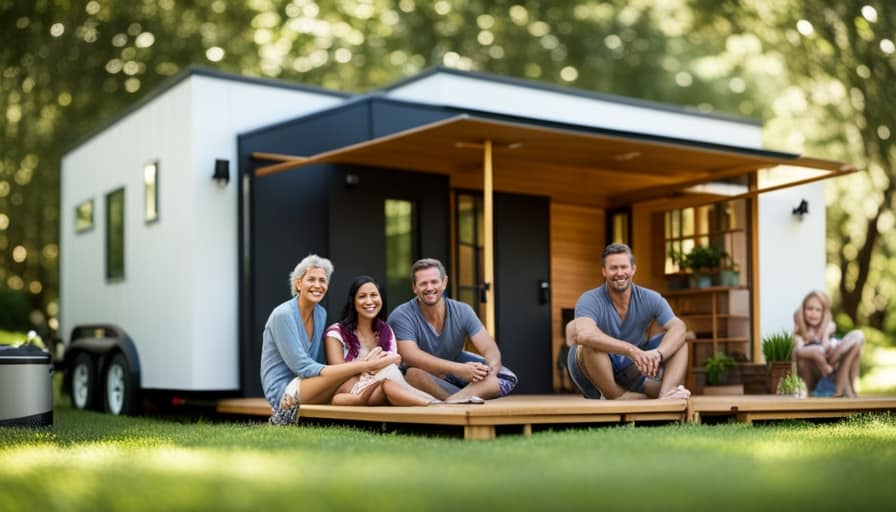
I’m Theodore, and I love tiny houses. In fact, I’m the author of Tiny House 43, a book about tiny houses that are also tree houses. I think they’re magical places where imaginations can run wild and adventures are just waiting to happen.
While tree houses are often associated with childhood, they can be the perfect adult retreat. They offer a cozy space to relax and unwind, surrounded by nature. And since they’re typically built on stilts or raised platforms, they offer stunning views that traditional homes simply can’t match.
If you’re looking for a unique and romantic getaway, a tree house tiny house might just be the perfect option.
Types of Tiny Houses
Pacifica: A Luxurious Oasis in a Compact Package
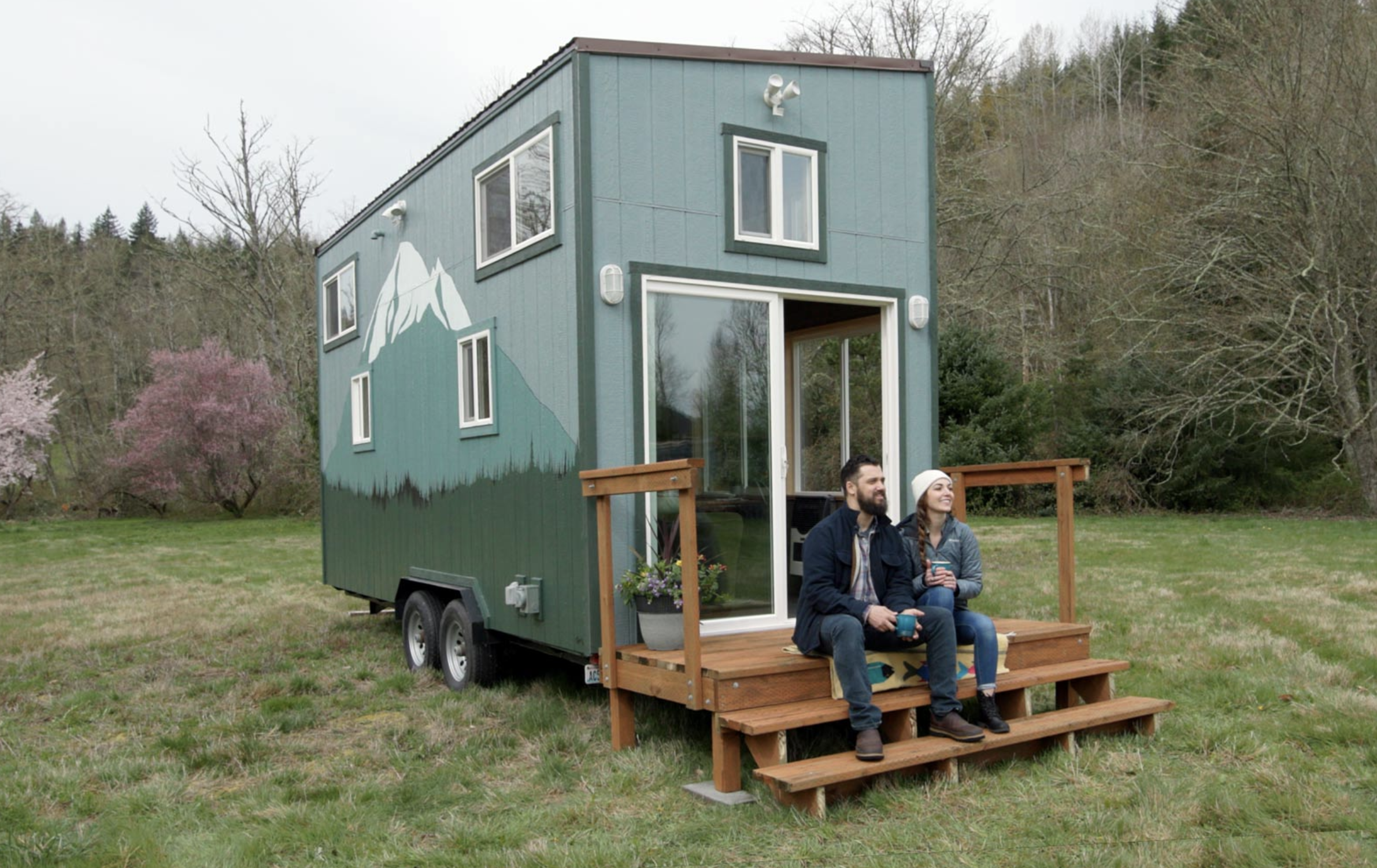
Experience Luxury In A Minimal Space With Pacifica
Luxury and minimalism can appear to be opposites, but the Pacifica tiny home by Mount Baker Tiny Homes beautifully shows how they can harmoniously coexist. This cozy dwelling offers a luxurious living experience in a small space, perfect for those who value extravagance but also crave simplicity. If you enjoy the finer things in life but also appreciate a clutter-free environment, this tiny home is the perfect solution for you.

The Pacifica is designed with a focus on functionality, efficiency, and natural light, creating a modern and inviting atmosphere that maximizes every inch of space.
The interior is thoughtfully designed, with custom-built cabinets, large picture windows, and high-end finishes that include African Mahogany dining tables and Montana Ghostwood shiplap accents. The result is a stunning and comfortable living space that offers plenty of storage and all the amenities of a larger home, without the excess.
In this article, we will delve into the design features, functional layout, and quality materials that make the Pacifica a top choice for those seeking a luxurious minimalistic lifestyle.
Key Takeaways
- The Pacifica tiny home from Mount Baker Tiny Homes offers a luxurious living experience in a small space, with a focus on functionality, efficiency, and natural light.
- The interior design and features of the Pacifica include custom-built cabinets, large picture windows, high-end finishes, and multi-functional furniture design that efficiently utilizes every inch of space.
- Sustainability is a key component of the Pacifica’s design, with the use of durable and sustainable materials, energy-efficient appliances, and the company’s commitment to sustainability.
- The Pacifica is a prime example of how quality materials and craftsmanship can create a luxurious and sustainable living space in a minimalistic design, with customizable options such as a custom African Mahogany dining table and an office area with a cabinet.
Design Features
The Pacifica from Mount Baker Tiny Homes boasts design features that prioritize luxury and efficiency in a minimal living space. The custom-built cabinets with butcher-block countertops, natural wood paneling, and Montana Ghostwood shiplap accent wall create a warm and inviting atmosphere, while the loft stairway with built-in storage maximizes the available square footage.
One of the most impressive design features of the Pacifica is the emphasis on maximizing natural light. The large picture windows and ample use of natural wood paneling create a bright and airy space.
Additionally, the Pacifica offers customizable options such as a custom African Mahogany dining table and an office area with a cabinet to further enhance the luxury and functionality of the living space. These design features, along with the efficient use of space, make the Pacifica an ideal choice for singles or couples seeking a luxurious and minimalistic living experience.
Functional and Efficient Layout
Efficiently utilizing every inch of space, the Pacifica’s carefully designed layout maximizes functionality without sacrificing comfort. The tiny home’s layout is a testament to the ingenuity and creativity of the team behind Mount Baker Tiny Homes. The Pacifica’s layout features a multi-functional furniture design that serves multiple purposes, making it an ideal choice for those who want to experience luxury in a minimal space.
To maximize space, the Pacifica’s living area includes a custom-built cabinet with a butcher-block countertop that serves as a workstation as well as a dining table. The stairs leading up to the loft area feature built-in storage compartments, allowing for the efficient use of space. Additionally, the loft area features a cozy sleeping area that comfortably fits a double bed.
Overall, the Pacifica’s layout is designed to provide ample living space while maintaining a minimalistic and efficient design.
- Custom-built cabinet with butcher-block countertop that serves as a workstation and dining table
- Stairs with built-in storage compartments
- Loft area with a cozy sleeping area that comfortably fits a double bed.
Quality Materials and Craftsmanship
Remarkably, Pacifica’s construction is a testament to the exceptional quality of materials and craftsmanship employed by the skilled team at Mount Baker Tiny Homes. Durable and sustainable materials are used in every aspect of the tiny home’s design.

The vinyl flooring, natural wood paneling, and Montana Ghostwood shiplap accent wall are aesthetically pleasing and built to last. The custom-built cabinets with butcher-block countertop and deep stainless steel sink are functional and add a touch of luxury to the space.
The Mount Baker Tiny Homes team has clearly prioritized durability over aesthetics, without sacrificing the latter. Using sustainable materials such as African Mahogany and incorporating energy-efficient appliances like the on-demand tankless water heater and propane furnace further demonstrate the company’s commitment to sustainability.
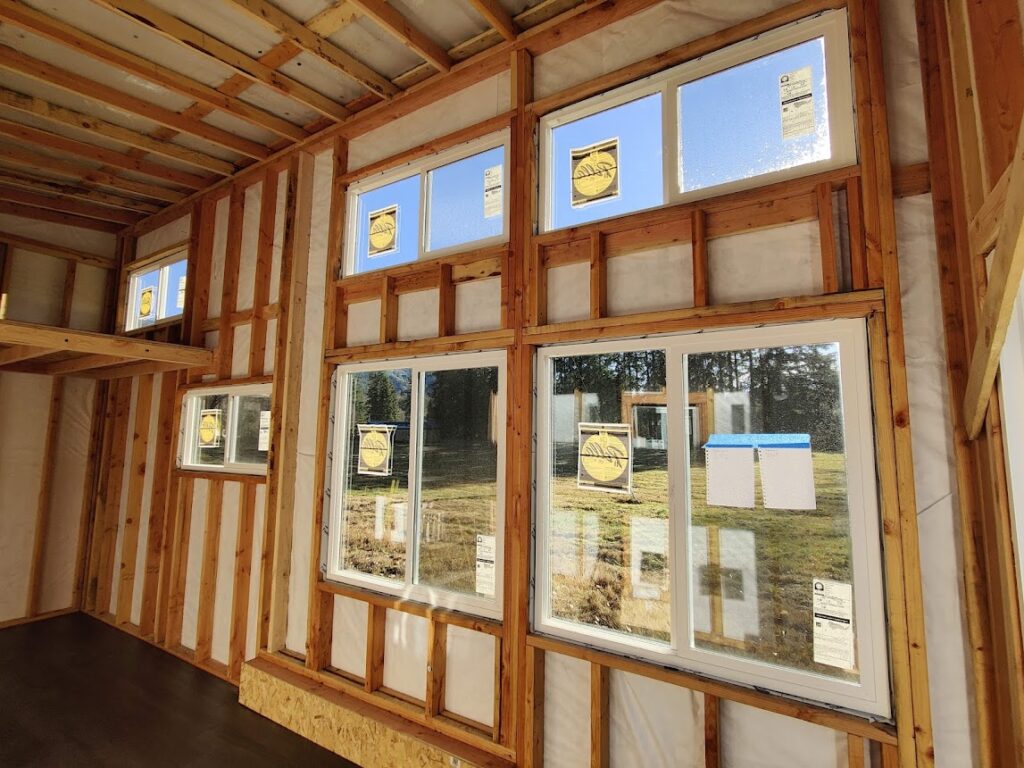
The Pacifica is a prime example of how quality materials and craftsmanship can create a luxurious and sustainable living space in a minimalistic design.
Frequently Asked Questions
What is the overall size and weight of the Pacifica tiny home?
The Pacifica tiny home, designed and built by Mount Baker Tiny Homes, is a light and strong structure that maximizes natural light.
The overall size and weight of the Pacifica depend on the specific configuration and customization, but the standard model has a size of 20 feet long, 8.5 feet wide, and 13.5 feet high, with a weight of approximately 10,000 pounds.
The Pacifica is portable, with a trailer that is custom-built to accommodate the tiny home’s size and weight.
The construction materials used in the Pacifica include natural wood paneling, Montana Ghostwood shiplap accent wall, vinyl flooring, custom-built cabinets with butcher-block countertop, and deep stainless steel sink.
The Pacifica also features a loft stairway with storage, a flushing toilet, a vanity, a rain shower head, a cozy loft area for double bed, a combo washer/dryer, a propane furnace, and an on-demand tankless water heater.
Additionally, the Pacifica has an office area with cabinet, storage under stairs, and a custom African Mahogany dining table.
Overall, the Pacifica tiny home offers a luxurious and high-quality living space in a minimalistic design that is perfect for singles or couples seeking a comfortable and efficient lifestyle.
Are there any additional customization options available for the Pacifica model?
The Pacifica tiny home from Mount Baker Tiny Homes offers a luxurious and high-quality living experience in a minimalistic space. One of the key advantages of the Pacifica model is its design flexibility, which allows for customization options that cater to the unique needs and preferences of the target audience.
The company offers a range of options for customizing the interior and exterior of the Pacifica, including changes to the layout, materials used, and color schemes. This provides buyers with the ability to personalize their tiny home and make it truly their own.
With its light, strong, and natural design, the Pacifica model is an excellent choice for singles or couples who want to experience the luxury of a well-built, energy-efficient tiny home.
How does the Pacifica ensure proper ventilation and air flow within the living space?
The Pacifica tiny home by Mount Baker Tiny Homes features a ventilation design that ensures proper air flow within the compact living space.
The home is equipped with multiple windows, including large picture windows, which not only provide natural light but also allow for cross-ventilation.
Additionally, the home is fitted with a propane furnace and on-demand tankless water heater, which facilitate proper ventilation through exhaust systems.
The flushing toilet and rain shower head also aid in maintaining good air quality.
Overall, the Pacifica’s ventilation design is a key feature that ensures a comfortable and healthy living environment in a small space.
Can the Pacifica be used as a full-time residence, or is it better suited for temporary living situations?
When it comes to the Pacifica tiny home from Mount Baker Tiny Homes, the question of whether it can be used as a full-time residence or is better suited for temporary living situations is a valid one.
While the Pacifica certainly offers luxury amenities and a beautiful, natural light-filled space, it is important to consider the space optimization aspect as well.
The Pacifica is designed to maximize storage and functionality in a minimal space, which can be ideal for those looking to downsize or simplify their lives.
However, when it comes to full-time living, some may find the space limitations to be a challenge.
Ultimately, the decision of whether the Pacifica is suitable for full-time living or temporary stays will depend on individual preferences and needs.
Does Mount Baker Tiny Homes offer any financing options for those interested in purchasing a Pacifica?
Mount Baker Tiny Homes does offer financing options for those interested in purchasing the Pacifica. However, the eligibility criteria for financing options are not explicitly stated on their website.
It is recommended that interested buyers contact the company directly to inquire about financing options and eligibility requirements.
Additionally, it is important to note that while the Pacifica is affordable for a luxury tiny home, it is still a significant investment.
Potential buyers should carefully consider their financial situation and budget before making a purchase and exploring financing options.
Conclusion
The Pacifica tiny home from Mount Baker Tiny Homes is a luxurious living experience in a small space. Its design features include large picture windows, custom-built cabinets, and high-end finishes like African Mahogany dining tables and Montana Ghostwood shiplap accents.
The functional and efficient layout offers plenty of interior storage, making it a perfect choice for singles or couples looking to embrace minimalistic living without sacrificing luxury. The quality materials and craftsmanship of the Pacifica make it a hit among tiny home enthusiasts.
With a focus on light, strength, and natural light, this compact abode offers a unique living experience that is both practical and elegant. The Pacifica is a perfect example of how minimalistic living can be both affordable and luxurious.
In conclusion, the Pacifica tiny home from Mount Baker Tiny Homes is a must-see for anyone looking for a unique living experience. Its design features, functional layout, and quality materials make it a perfect choice for those who want to embrace minimalistic living without sacrificing luxury.
The Pacifica is a true masterpiece of craftsmanship and design, and it is sure to impress anyone who steps inside. So, if you are looking for a luxurious living experience in a small space, look no further than the Pacifica.
Hi, I’m Emma. I’m the Editor in Chief of Tiny House 43, a blog all about tiny houses. While tree houses are often associated with childhood, they can be the perfect adult retreat. They offer a cozy space to relax and unwind, surrounded by nature. And since they’re typically built on stilts or raised platforms, they offer stunning views that traditional homes simply can’t match. If you’re looking for a unique and romantic getaway, a tree house tiny house might just be the perfect option.
Prefab Tiny Houses
How Difficult Is It to Set up a Tiny House as a Permanent Structure
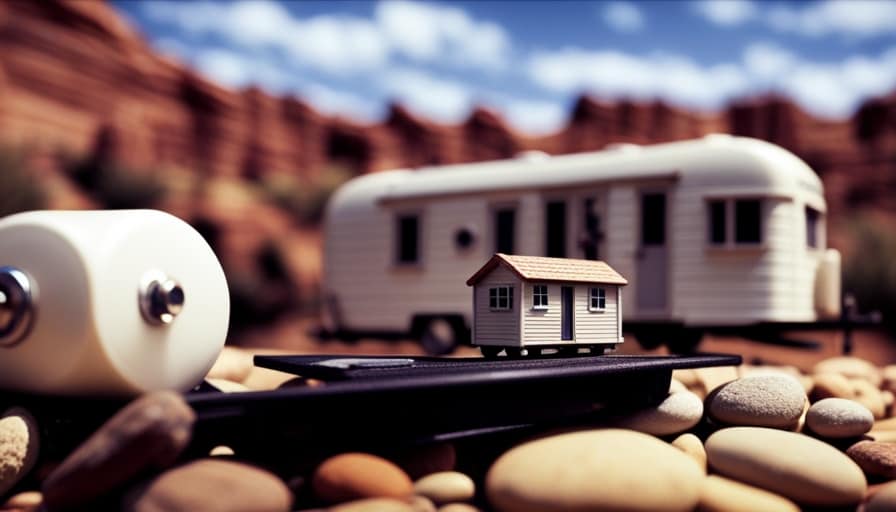
Upon entering a tiny house, I am struck by its efficient design and cozy atmosphere. However, the question lingers for many prospective homeowners: How challenging is it to establish a tiny house as a permanent structure?
In this article, we will explore the zoning regulations, legal considerations, and financial challenges that come with this unique housing option. Join me as we navigate the process of turning a tiny house into a home.
Key Takeaways
- Understanding and navigating zoning regulations and building codes is crucial for setting up a tiny house as a permanent structure.
- Securing utilities, including water supply and electricity connection, can be a challenging process that requires working with local utility companies and meeting safety requirements.
- Ensuring structural stability of a tiny house involves consulting with a structural engineer, assessing soil conditions, and choosing an appropriate foundation option.
- Designing and optimizing space in a tiny house requires careful consideration of furniture placement, multi-functional design elements, and clever storage solutions.
Zoning Regulations and Legal Considerations
One of the first things I learned when looking into setting up a tiny house as a permanent structure was the importance of understanding zoning regulations and legal considerations.
Zoning regulations determine where you can place your tiny house and what it can be used for. Different areas have different requirements, so it’s crucial to research and comply with local building codes. These codes dictate the size, materials, and safety standards for constructing your tiny house.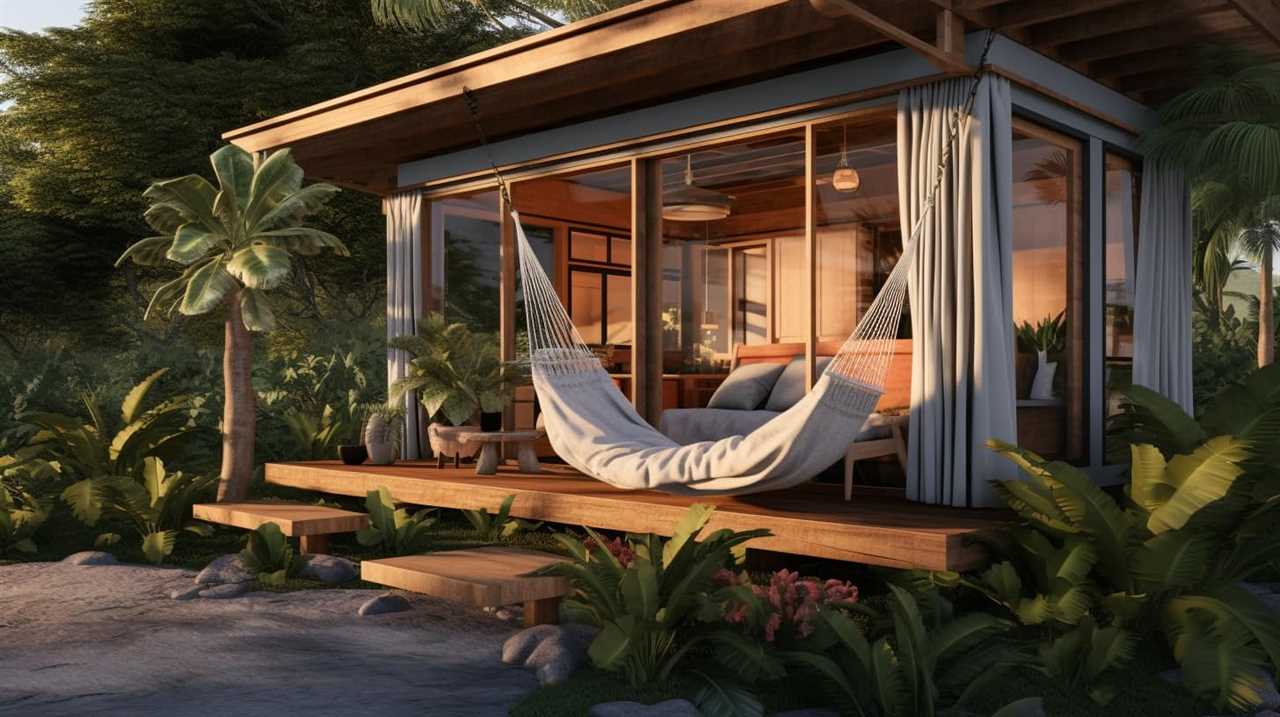
Additionally, the permitting process is an essential step in ensuring that your tiny house meets all necessary regulations and receives the proper approvals. This process involves submitting detailed plans, paying fees, and undergoing inspections to ensure compliance with zoning laws and building codes.
Understanding and navigating these zoning regulations and legal considerations is key to successfully setting up a tiny house as a permanent structure.
Securing Utilities for a Tiny House
I can tell you that securing utilities for a tiny house can be a challenging process.
When it comes to securing water supply, there are a few options to consider. You could connect to a municipal water source if your tiny house is located in an area with access to one. Another option is to have a well drilled on your property, which would provide you with a private water supply. However, this can be costly and may require permits and inspections.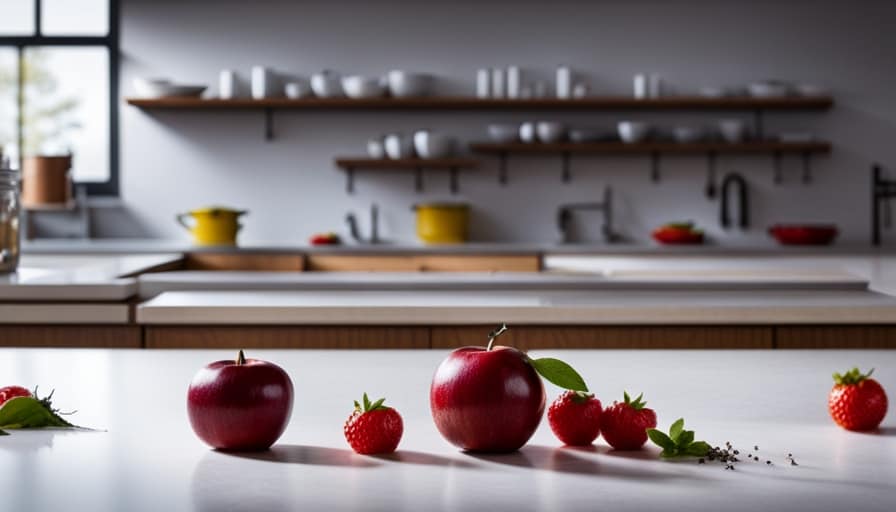
As for connecting to the electric grid, you’ll need to work with your local utility company to ensure that your tiny house is properly connected and meets all safety requirements. This may involve installing a meter and connecting to the existing electrical infrastructure.
Ensuring Structural Stability of a Tiny House
To ensure the structural stability of my tiny house, I must carefully inspect and reinforce the foundation and framing.
One of the key aspects of maintaining a solid foundation is to consider the type of soil and climate in the area. This will help determine the appropriate foundation options, such as concrete piers, helical piles, or a traditional concrete slab. It’s crucial to consult with a structural engineer or a professional contractor to assess the soil conditions and recommend the best foundation option for your tiny house.
Additionally, structural modifications may be necessary to reinforce the framing and ensure the overall stability of the structure. These modifications could include adding additional support beams or braces, reinforcing connections, or using high-quality materials.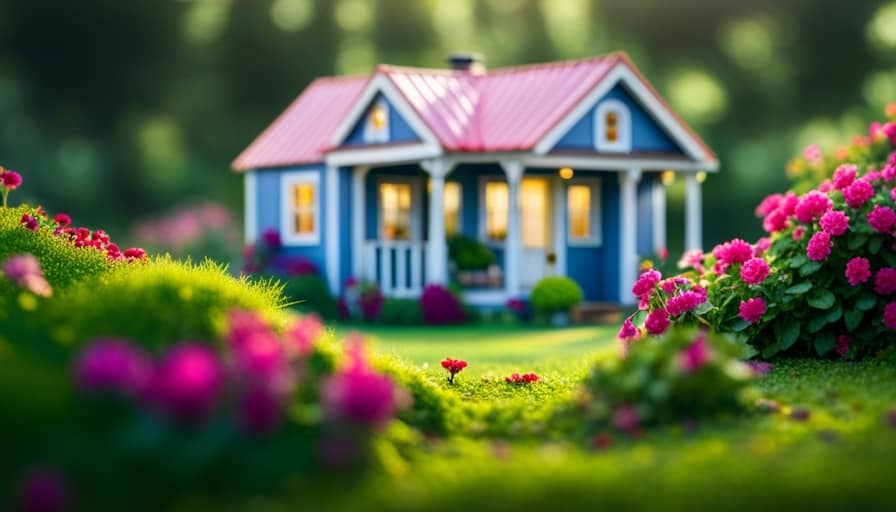
Designing and Optimizing Space in a Tiny House
Designing and optimizing space in my tiny house requires careful consideration of furniture placement, storage solutions, and multi-functional design elements.
To maximize storage in my tiny house, I utilize space-saving furniture that serves dual purposes. For example, my sofa doubles as a pull-out bed, providing additional sleeping space for guests. I also have a dining table with built-in storage compartments, allowing me to store items such as linens and cutlery.
Additionally, I make use of vertical space by installing shelves and hooks on the walls to hang pots, pans, and utensils. Every nook and cranny is utilized, with hidden storage compartments under the stairs and in the walls.
Financial and Budgeting Challenges of Setting up a Tiny House
Setting up a tiny house can present financial challenges, but with careful budgeting and planning, it’s possible to create a comfortable and sustainable living space.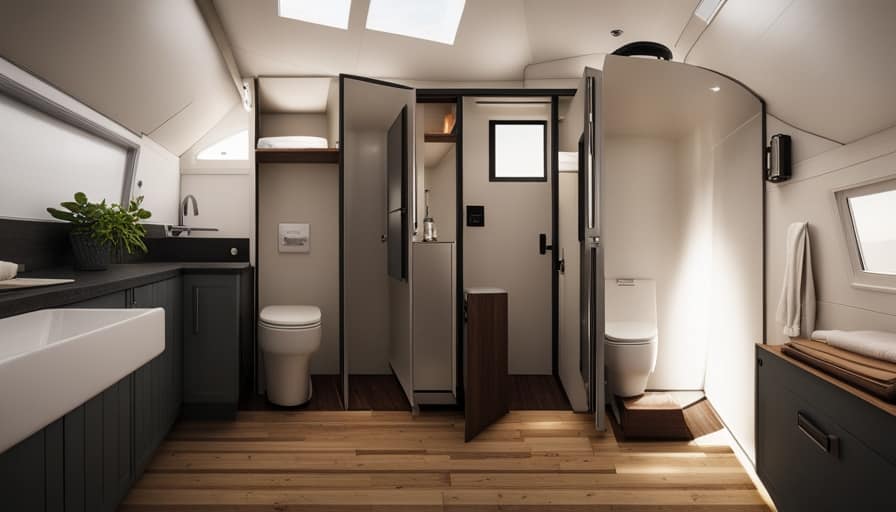
When considering the cost implications of setting up a tiny house, it’s important to factor in the initial purchase or construction costs, as well as ongoing expenses such as utilities, maintenance, and insurance.
Additionally, long-term sustainability should be taken into account to ensure that the tiny house remains affordable and efficient over time. This can include investing in energy-efficient appliances, utilizing renewable energy sources, and implementing water-saving measures.
Frequently Asked Questions
How Long Does It Typically Take to Set up a Tiny House as a Permanent Structure?
Setting up a tiny house as a permanent structure can be a time-consuming process. It requires careful planning, overcoming challenges, and considering various factors. Ensuring a smooth and efficient process is crucial for a successful outcome.
Are There Any Specific Restrictions on the Size of a Tiny House in Certain Areas?
Size restrictions and zoning regulations vary by area, so it’s important to research local laws before setting up a tiny house. These restrictions can dictate the maximum size and location of the structure.
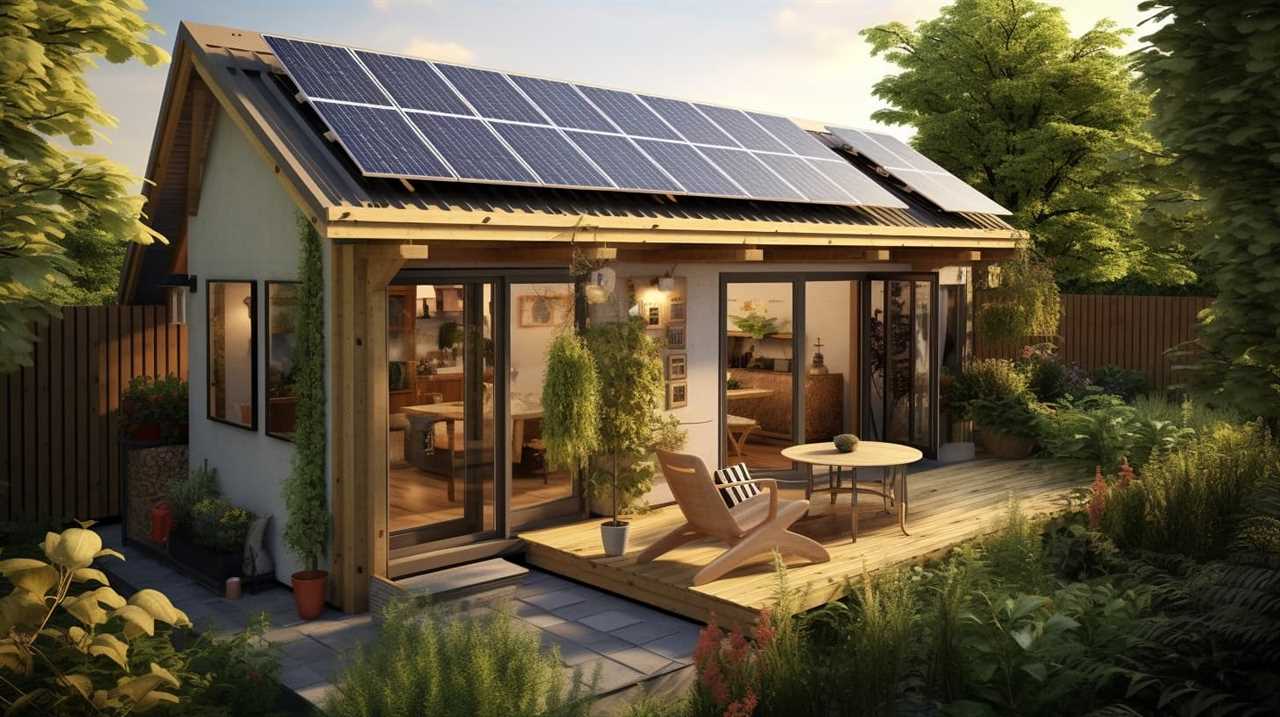
What Are the Main Factors to Consider When Choosing a Location for a Tiny House?
When choosing a location for a tiny house, it’s important to consider zoning regulations and access to utilities. Zoning regulations determine if tiny houses are allowed, while access to utilities ensures a comfortable and convenient living experience.
Are There Any Special Permits Required for Setting up a Tiny House in Certain Areas?
Special permits and zoning restrictions vary depending on the location. It’s important to research and understand the specific requirements for setting up a tiny house in certain areas to ensure compliance with local regulations.
Can a Tiny House Be Easily Relocated if Needed in the Future?
Relocating a tiny house can be quite the adventure! From navigating transportation logistics to overcoming challenges of moving a permanent structure, it requires careful planning and execution.
Conclusion
In conclusion, setting up a tiny house as a permanent structure can be a challenging process. From navigating zoning regulations to securing utilities and ensuring structural stability, there are many considerations to take into account.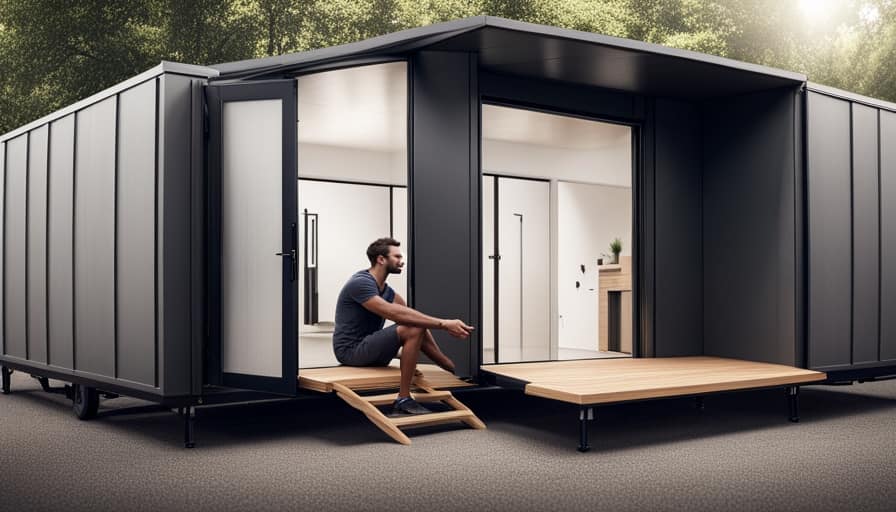
Additionally, designing and optimizing space in a tiny house can be a creative yet demanding task. Maximizing storage, creating multi-functional areas, and utilizing clever design solutions are essential for making the most of limited square footage.
Lastly, the financial and budgeting challenges of setting up a tiny house can’t be overlooked. While tiny houses are often touted as a more affordable housing option, the upfront costs of purchasing or building a tiny house, as well as ongoing expenses like land rental or mortgage payments, utilities, and maintenance, must be carefully considered and planned for.
So, are you ready to embark on this unique and rewarding journey?
I’m Theodore, and I love tiny houses. In fact, I’m the author of Tiny House 43, a book about tiny houses that are also tree houses. I think they’re magical places where imaginations can run wild and adventures are just waiting to happen.
While tree houses are often associated with childhood, they can be the perfect adult retreat. They offer a cozy space to relax and unwind, surrounded by nature. And since they’re typically built on stilts or raised platforms, they offer stunning views that traditional homes simply can’t match.
If you’re looking for a unique and romantic getaway, a tree house tiny house might just be the perfect option.
-

 Beginners Guides6 months ago
Beginners Guides6 months agoHow To Buy A Tesla Tiny House
-

 Energy Efficiency4 months ago
Energy Efficiency4 months agoBest Tiny Homes For Cold Climates
-

 Beginners Guides6 months ago
Beginners Guides6 months agoTiny House Nation Where Are They Now Stephanie
-

 Tiny House Resources (e.g., legalities, cost, insurance, FAQs)4 months ago
Tiny House Resources (e.g., legalities, cost, insurance, FAQs)4 months agoDo Tiny Homes Need Planning Permission?
-

 Beginners Guides3 months ago
Beginners Guides3 months agoFrom The Show Tiny House Nation How Many Keep Their Tiny House?
-

 Beginners Guides4 months ago
Beginners Guides4 months agoUsing a Climbing Net For Treehouse Construction
-

 Beginners Guides4 months ago
Beginners Guides4 months agoHow to Build a Treehouse Rope Bridge
-

 Beginners Guides4 months ago
Beginners Guides4 months agoHow to Build a Treehouse Without Drilling Into the Tree



